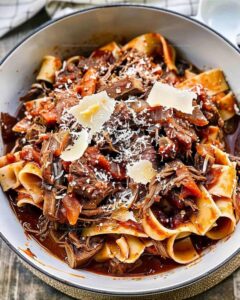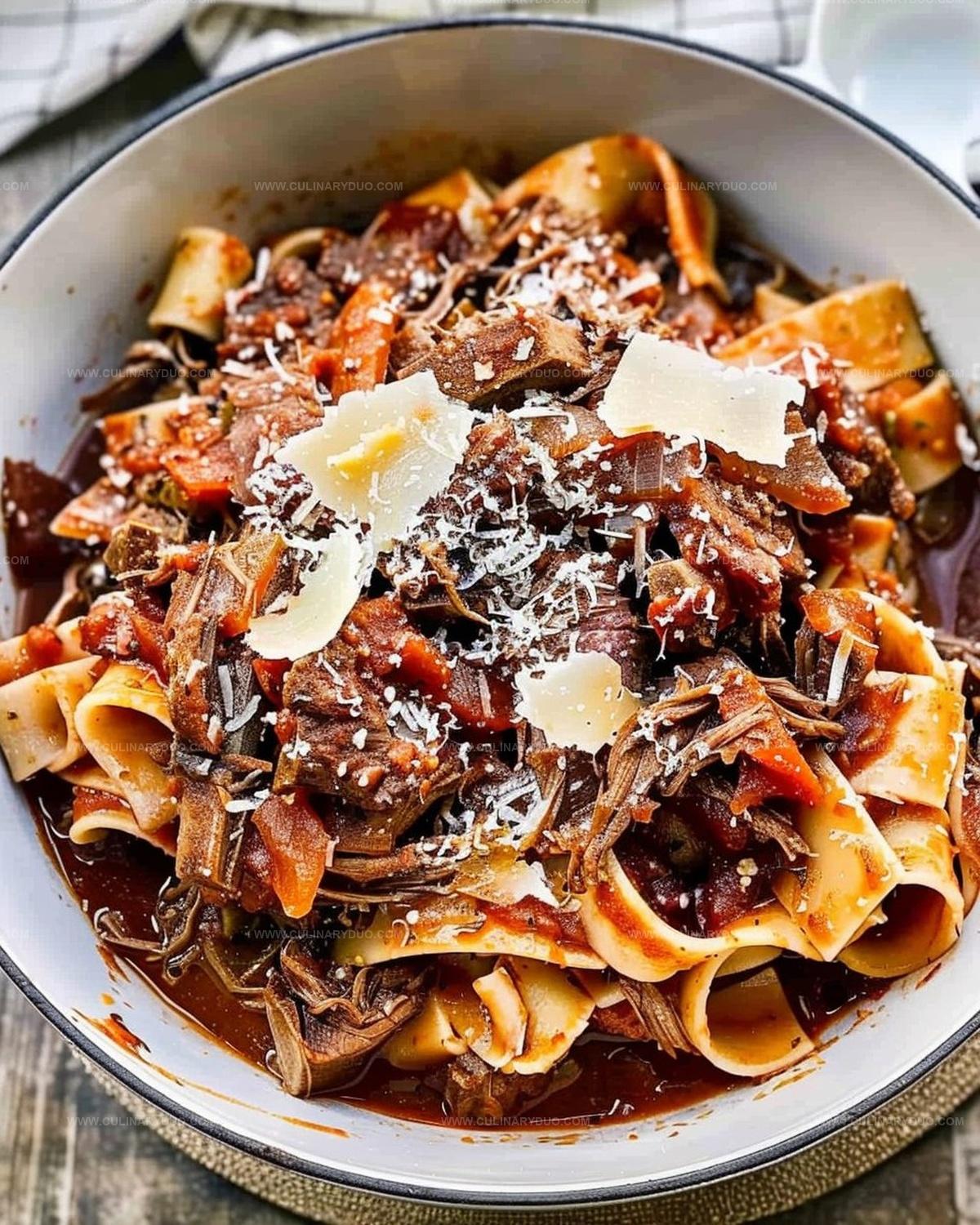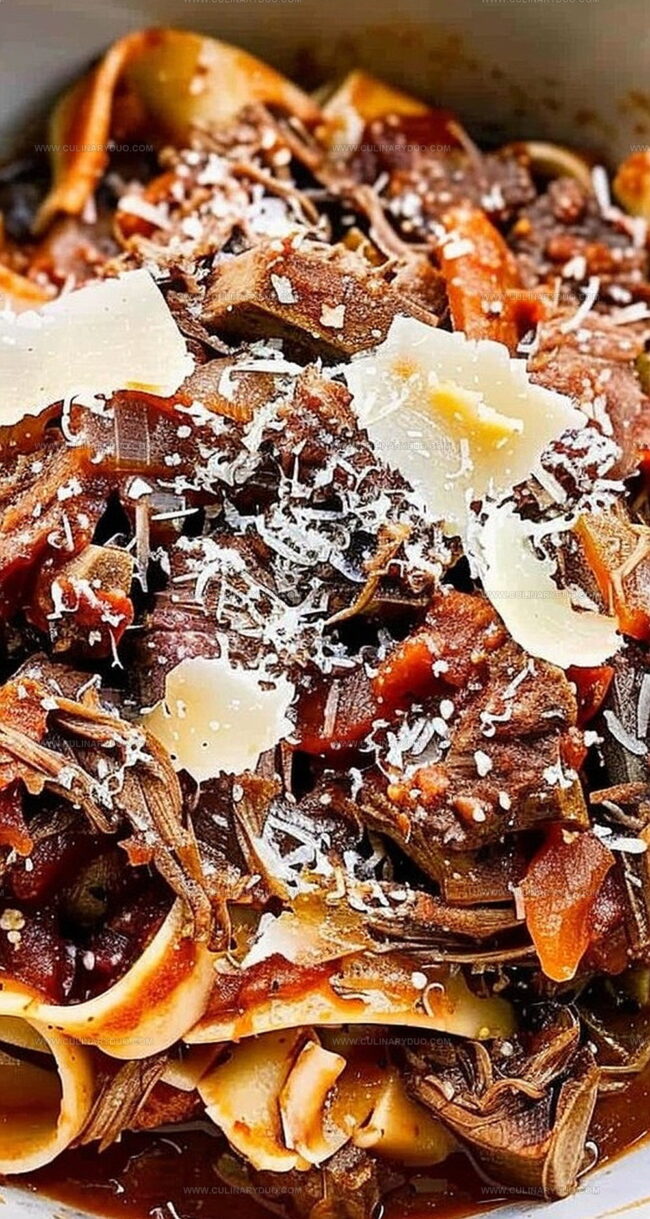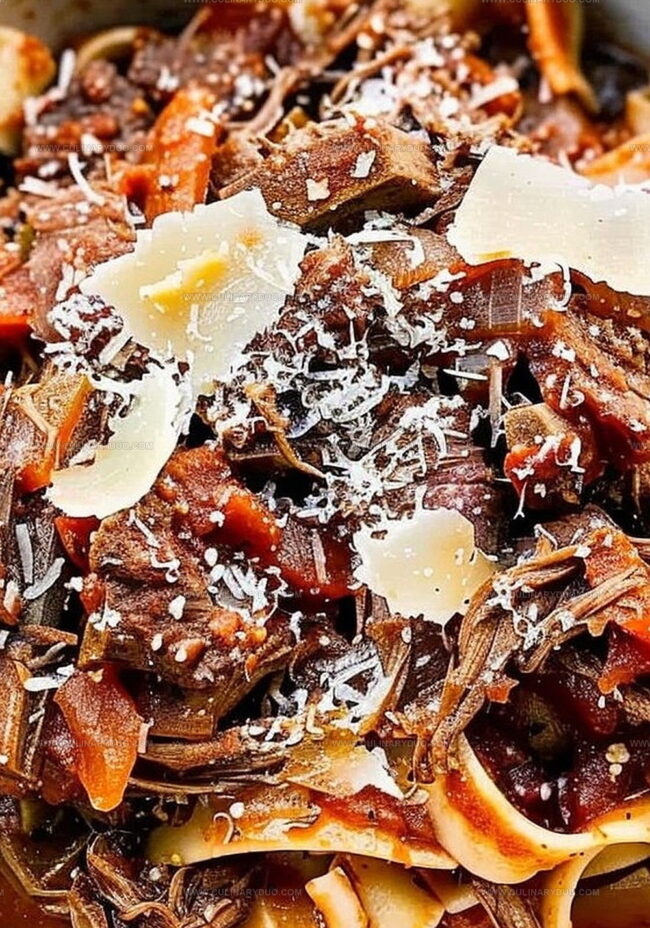Rustic Short Rib Ragu Recipe: A Cozy Italian Classic
When comfort meets culinary magic, this short rib ragu recipe promises a symphony of rich, tender flavors that dance across your palate.
Slow-cooked beef transforms into a luxurious sauce that clings perfectly to wide pasta ribbons.
Hearty and deeply satisfying, this dish emerges from hours of patient simmering and careful seasoning.
Robust red wine melds with aromatic herbs to create depth and complexity in every single bite.
Tender short ribs break down into succulent, melt-in-your-mouth meat that speaks of rustic Italian traditions.
Each spoonful carries the warmth of a carefully crafted meal, inviting you to savor every incredible moment.
This ragu will become your new favorite cold-weather companion, ready to comfort and delight.
Rich Short Rib Ragu Flavors
Essential Ingredients for Short Rib Ragu
Meat:Aromatics and Vegetables:Herbs and Seasonings:Liquid and Sauce Components:Thickening and Finishing Ingredients:Serving Accompaniments:Step-by-Step Short Rib Ragu Instructions
Step 1: Prepare the Beef
Grab your short ribs and generously season them with salt and pepper.
Heat a splash of olive oil in a heavy Dutch oven over a sizzling medium-high flame.
Carefully place the ribs into the hot pan and sear them until they develop a deep golden-brown crust on all sides.
Once beautifully browned, transfer the meat to a temporary plate.
Step 2: Create the Flavor Base
Reduce the heat to medium and add chopped onions, carrots, celery, and minced garlic to the same pot.
Let these vegetables dance and soften for 3-5 minutes, releasing their aromatic goodness.
Pour in a generous splash of red wine to deglaze the pot, scraping up all those delicious browned bits from the bottom.
Allow the wine to simmer and reduce for another 3 minutes.
Step 3: Build the Robust Sauce
Time to layer in the flavor!
Add these ingredients:Carefully return the seared short ribs to the pot, nestling them into the sauce.
Step 4: Slow Simmer
Bring the mixture to a rolling boil, then immediately reduce the heat.
Cover the pot and let everything simmer gently for 2 hours.
The meat will become incredibly tender during this time.
Step 5: Shred and Prepare
Remove the bay leaves, thyme sprigs, and cheese rind.
Using two forks, shred the meat, discarding the bones.
The meat should be falling apart and incredibly succulent.
Step 6: Final Touches
Return the shredded meat to the pot and continue simmering for another 30 minutes.
If you prefer a thicker sauce, mix a bit of the liquid with cornstarch and stir back into the pot.
Step 7: Cook the Pasta
Bring a large pot of salted water to a boil.
Cook your favorite pasta until it reaches that perfect al dente texture.
Using tongs, transfer the pasta directly into the ragu, allowing it to absorb all those incredible flavors.
Step 8: Serve with Flair
Ladle the rich, meaty ragu over the pasta.
Garnish with freshly grated parmesan or creamy burrata, a sprinkle of flaky sea salt, and a scattering of chopped fresh basil.
Enjoy this comforting, restaurant-quality meal right at home!
Tips for Rich and Tender Short Rib Ragu
Variations for Short Rib Ragu
Serving Ideas for Short Rib Ragu
Storage Guidance for Short Rib Ragu
FAQs
Short ribs are ideal because they’re rich in connective tissue and fat, which break down during slow cooking, creating incredibly tender and flavorful meat that melts in your mouth.
Dutch ovens distribute heat evenly and retain moisture, making them perfect for long, slow cooking processes like braising short ribs, which helps develop deep, complex flavors.
Use beef broth or grape juice as alternatives. These substitutes will still provide depth and help deglaze the pan, capturing all the delicious browned bits from searing the meat.
Print
Short Rib Ragu Recipe
- Total Time: 2 hours 50 minutes
- Yield: 6 1x
Description
Hearty Short Rib Ragu delivers rich Italian comfort straight from slow-cooked beef braised in red wine and herbs. Pasta lovers will savor tender meat melting into silky sauce that whispers classic Mediterranean warmth for you.
Ingredients
Meat:
- 2.5 pounds bone-in beef short ribs
Herbs and Spices:
- 1/2 teaspoon kosher salt
- 1/2 teaspoon black pepper
- 3 sprigs fresh thyme
- 1/2 teaspoon dried oregano leaves
- 1/2 teaspoon dried basil leaves
- 2 bay leaves
- Pinch of crushed red pepper flakes
Vegetables and Liquids:
- 1 small onion (finely diced)
- 1 large carrot (finely diced)
- 1 celery rib (finely diced)
- 4 cloves garlic (minced)
- 2 tablespoons olive oil
- 1/2 cup dry red wine (Chianti, Cabernet Sauvignon, Merlot)
- 1 3/4 cups low-sodium beef broth
- 2 teaspoons beef bouillon paste
- 28 ounces can peeled whole tomatoes (San Marzano recommended, hand crushed)
- 2 tablespoons tomato paste
- 1 parmesan cheese rind
- Salt and pepper to taste
Pasta:
- 1 pound pappardelle or tagliatelle pasta
Instructions
- Prepare the short ribs by generously seasoning with salt and pepper, ensuring even coverage for maximum flavor infusion.
- Heat olive oil in a Dutch oven over medium-high heat until shimmering, then meticulously sear the short ribs on all sides to develop a rich, caramelized exterior, approximately 3-4 minutes per side.
- Reduce heat to medium and introduce a classic sofrito of finely chopped onion, carrot, celery, and minced garlic, sautéing until vegetables soften and become translucent, about 4-5 minutes.
- Deglaze the pot with red wine, scraping up any browned bits from the bottom, and allow the liquid to reduce by half, concentrating the aromatic flavors.
- Create the ragu base by adding beef broth, bouillon paste, crushed tomatoes, tomato paste, cheese rind, and a harmonious blend of herbs including oregano, basil, thyme, bay leaves, and a pinch of crushed red pepper.
- Carefully return the seared short ribs to the pot, ensuring they are nestled within the sauce, and bring the mixture to a gentle boil.
- Reduce heat to low, cover the Dutch oven, and allow the ragu to simmer slowly for 2 hours, developing deep, complex flavors and tenderizing the meat.
- Remove bay leaves, thyme sprigs, and cheese rind, then carefully extract the meat from the bones, shredding it into succulent, tender pieces.
- Reintroduce the shredded meat to the sauce, continuing to simmer for an additional 30 minutes to meld the flavors and achieve a luxurious consistency.
- If a thicker sauce is desired, create a cornstarch slurry by mixing a small amount of sauce with cornstarch, then gently incorporate back into the pot.
- Cook pasta in generously salted water until perfectly al dente, then transfer directly into the ragu using tongs, allowing the pasta to absorb the rich sauce.
- Plate the ragu-coated pasta, garnishing with freshly grated parmesan, creamy burrata, flaky sea salt, and a sprinkle of chopped fresh basil for a final touch of brightness.
Notes
- Tenderize the short ribs by searing at high heat to lock in rich, deep flavors and create a beautiful caramelized exterior that adds complexity to the sauce.
- Opt for a robust red wine like Cabernet Sauvignon or Merlot to enhance the meat’s depth and provide a subtle acidity that cuts through the richness.
- Allow ample simmering time to break down tough meat fibers, transforming short ribs into melt-in-your-mouth tender chunks that easily shred and absorb sauce flavors.
- Customize the spice level by adjusting crushed red pepper or adding smoked paprika for extra warmth without overwhelming the dish’s delicate balance.
- Prep Time: 20 minutes
- Cook Time: 2 hours 30 minutes
- Category: Lunch, Dinner
- Method: Simmering
- Cuisine: Italian
Nutrition
- Serving Size: 6
- Calories: 620 kcal
- Sugar: 5 g
- Sodium: 430 mg
- Fat: 28 g
- Saturated Fat: 9 g
- Unsaturated Fat: 17 g
- Trans Fat: 0.3 g
- Carbohydrates: 47 g
- Fiber: 6 g
- Protein: 46 g
- Cholesterol: 130 mg




Natalie Brooks
Co-Founder & Content Strategist
Expertise
Education
eCornell
Natalie brings the vibrant, plant-powered side to Culinary Duo. After earning her Plant-Based Nutrition Certificate from eCornell, she combined her love for fresh ingredients with a passion for storytelling, aiming to make healthy cooking simple and satisfying.
Her kitchen motto: good food doesn’t need a fancy label, it just needs fresh ideas and a little creativity. Outside of writing and recipe testing, Natalie’s happiest in her garden, exploring farmers’ markets, or mixing global flavors into new kitchen experiments.